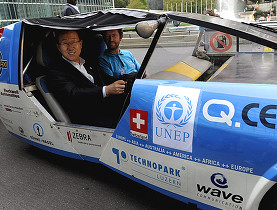Solar taxi lights up Big Apple

Swiss adventurer Louis Palmer has reached New York in his "Solartaxi", the first motor vehicle not powered by fossil fuel to travel around the world.
Palmer, who set off from Lucerne in July 2007, gave United Nations Secretary-General Ban Ki-moon a lift to work on Friday.
The 36-year-old teacher has already driven his solar-powered vehicle 43,000 kilometres across Europe, Asia, Australasia and the United States.
“…without spending a single cent on petrol,” stressed Palmer, as he presented the Solartaxi to the media at the Cooper-Hewitt National Museum for Design.
“It’s as reliable as a Swiss watch,” he added.
The Solartaxi, designed by Switzerland’s two federal institutes of technology in cooperation with private partners, consists of a solar vehicle and trailer with solar cells.
It is powered totally by solar energy: 50 per cent of the energy comes from the solar cells on the trailer; the other 50 per cent is produced and fed into the power grid on the roof of the Swisscom building just outside Bern and accessed via power sockets en route.
The Solartaxi, which has a maximum speed of 90km/h, thus uses electricity from 100 per cent renewable energy and releases no emissions into the atmosphere. It is however being accompanied by a conventional vehicle carrying everything needed for a trip around the world.
Childhood dream
Palmer’s trip is the fulfilment of a childhood dream. At the age of 14, he dreamt of driving around the world in car that wouldn’t harm the environment.
He says that although a lot is currently being talked about climate change, few concrete actions have been taken.
“With this trip I want to show people that technology which can be used on a daily basis exists for a clean and sustainable solution to the energy crisis,” he said.
Palmer believes that if he can drive around the world in his Solartaxi, there is no reason why such technology can’t become standard. He hopes to convince industry and investors that the time is ripe for solar transport.
He explained to an audience on the banks of the Hudson River that solar cars were not only environmentally friendly, but also cheap. Palmer estimates that a similar car could be sold on the market for around SFr15,000 ($13,250) – including solar cells.
“One dollar’s worth of electricity from the socket enables me to drive 100 miles [160 kilometres],” he said.
A New Yorker told swissinfo it was “embarrassing that it took someone from a country without an automobile industry to show us in the US that solar cars were not a load of nonsense”.
Another observer said: “I had no idea that there were such innovative and adventurous people in Switzerland.”
Open arms and ears
In order to get his message across, Palmer came up with the idea of a taxi. The three-wheeler has space for an additional person and he is using this to pick up fellow travellers along the way. Passengers can also drive, as the steering wheel slides across.
During his trip he has given lifts to a number of prominent people, including New York mayor Michael Bloomberg, Titanic director James Cameron and talk show host Jay Leno.
Palmer received much attention in particular at the UN climate conference in Bali in December.
At a time when oil is hovering around $100 a barrel and Americans are feeling the pinch at the pump, the Solartaxi is attracting a wide following.
“We’ve received fantastic welcomes everywhere,” he said. “We’re catching peoples’ eyes and they’re talking to us and responding.” Indeed his arrival in Washington made national headlines.
As for the future, Palmer says he has already got plans for his next challenge: an international race in which he himself will compete and for which he got inspiration from French author Jules Verne. It’s theme? “Around the world in 80 days using renewable energy”.
swissinfo, Rita Emch in New York
Switzerland receives about 40,000 billion kilowatt/hours of sunshine annually, or 220 times more than the country’s entire energy requirements.
There are more than 40,000 solar heating systems with a total surface of around 350,000 square metres.
Another 1,800 solar electricity systems are tied to the power grid, and countless others are in private hands, with a total surface of 170,000 square metres.
Altogether they produce 0.3% of the country’s heating requirements and 0.03% of its electricity.
Switzerland has 400 million square metres of roof surfaces that could be used for solar energy.
In 1990 a solar-powered car designed by Biel’s engineering school won the World Solar Challenge across Australia.
In May 2007 the Sun21 boat successfully completed a trans-Atlantic crossing.
In 2009 a 30-metre boat known as Planet solar will try to circumnavigate the globe.
In 2011 Swiss adventurer Bertrand Piccard hopes his Solar Impulse aircraft will fly around the world.
In the Intergovernmental Panel on Climate Change report in February 2007, scientists said it was “very likely” – or more than 90% probable – that global warming was man-made.
The report predicts a “best estimate” that temperatures will rise by 1.8-4°C in the 21st century, within a likely range from 1.1-6.4°C.
The study projects a rise in sea levels of 28-43cm in the 21st century – and said bigger gains could not be ruled out if ice sheets in Antarctica and Greenland thaw.

In compliance with the JTI standards
More: SWI swissinfo.ch certified by the Journalism Trust Initiative



You can find an overview of ongoing debates with our journalists here. Please join us!
If you want to start a conversation about a topic raised in this article or want to report factual errors, email us at english@swissinfo.ch.